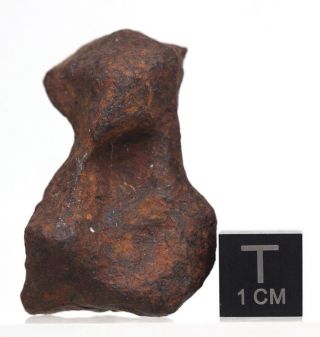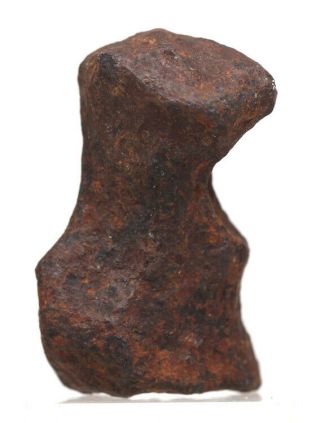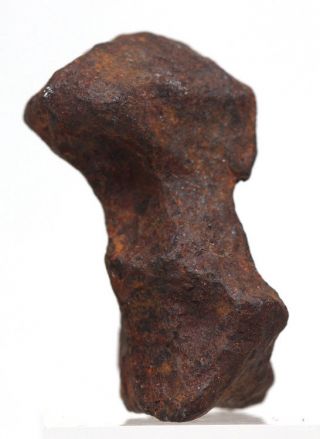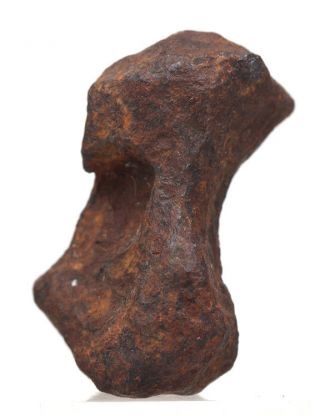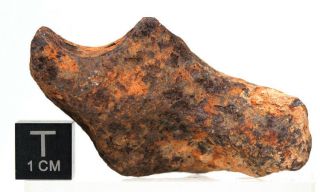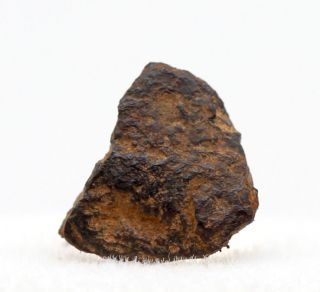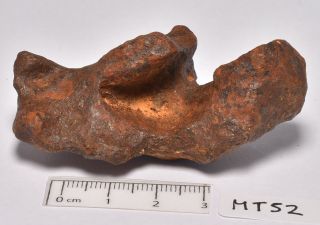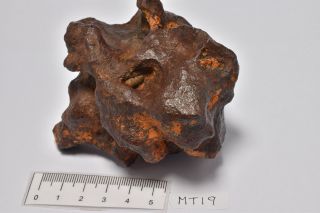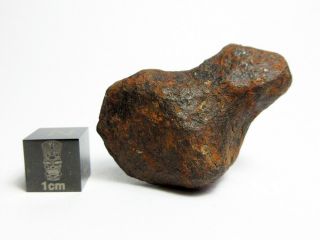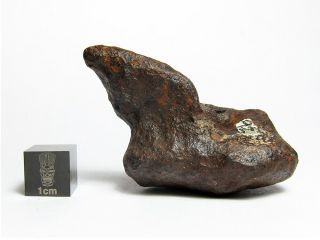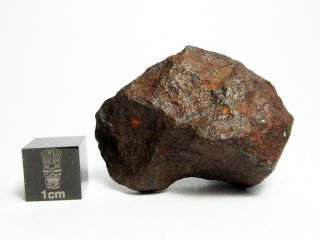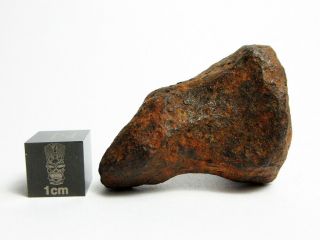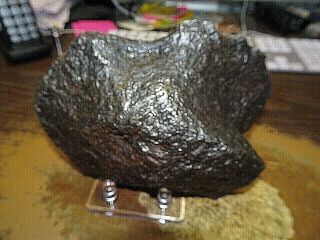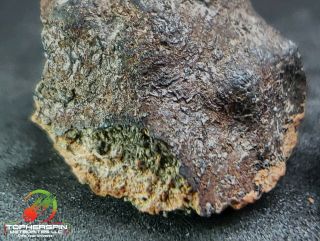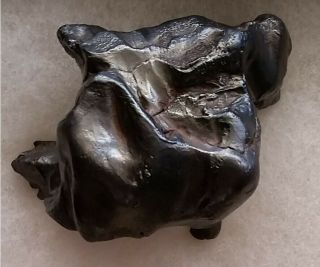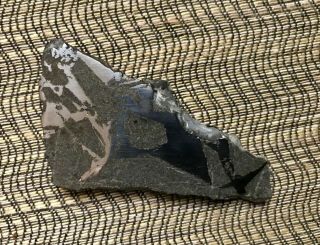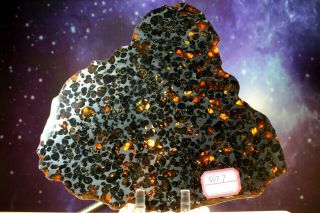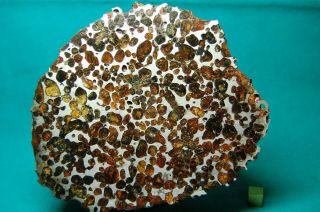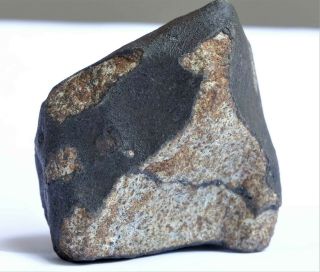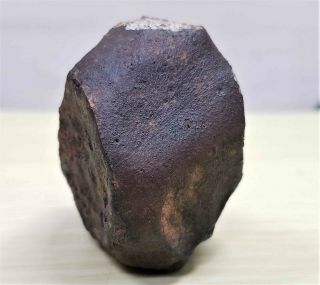Mundrabilla Iron Meteorite Mineral Sculptural Specimen AUSTRALIA Natural Patina
Item History & Price
| Reference Number: Avaluer:4490729 | Type: Meteorite Iron, IAB-ung |
| Size: 36 mm x 24 mm x 20 mm | Weight: 42.71 grams |
I offer a shipping discount for customers who combine their payments for multiple purchases into one payment!
The discount is regular shipping price for the first item and just 50 cents for each additional item!
To be sure you get your shipping discount just make sure all the items you want to purchase are in your cart.
Auctions you win are added to your cart automatically.
For any "buy it now..." items or second chance offers, be sure to click the "add to cart" button, NOT the "buy it now" button.
Onceall of your items are in your cart just pay for them from your cart andthe combined shipping discount should be applied automatically.
I offer a money back guarantee on every item I sell.
If you are not 100% happy with your purchase just send me a message to let me know
and I will buy back the item for your full purchase price.
Hi there, I am selling this Amazing Mundrabilla Iron Meteorite complete individual! Meteorites are one of the RAREST materials on earth, more rare than diamonds!!!! This one fell in Australia and is a piece of one of the largest meteorite falls ever discovered. This is a nice size whole piece with a very nice desert patina, and is in 'as found' condition, meaning it has not been cleaned. If you wanted to clean it, it would come out looking gunmetal shiny. This is one of the most prized possessions I have and I know it would make an AMAZING addition to any collection of ANY type, but especially of meteorites and stones! Don't let this one pass you by. Anyway, I am offering it here, now, for you. If you have any questions, do not hesitate to ask me. Thanks so much for visiting my listing and have a great day!
If you purchase from me you should know that the authenticity of this meteorite is guaranteed!
I am a member of the IMCA or the International Meteorite Collector's Association. This is an organization that is a check and balance of those who collect, trade and sell meteorites. You can only join this organization by having the utmost integrity. You must to have two references from existing members to get in and a good reputation. Members of this organization maintain a high standard by monitoring each others' activities for accuracy and honesty. It is every IMCA member's responsibility and pleasure to offer help and assistance to fellow members in order to ensure specimens are genuine. It is not wise to purchase meteorites on Ebay or other sources from those who are not IMCA members. This is a very tight-knit community made up of meteorite hunters, dealers, collectors, and scientists who look out for each other to make sure that the meteorites offered to the public are authentic and genuine. I encourage you to visit the IMCA website and get more information on what being a member means, and how your purchases from its members are guaranteed.
IMCA Member #7446Iron meteoriteFrom Wikipedia, the free encyclopediaIron meteorite— Type —TamentitMeteorite.JPGTamentit Iron Meteorite, found in 1864 in the Sahara, [1] weight about 500 kg. On display at Vulcania park in France.Compositional type IronParent body >50Composition Fe, Ni & Co (>95%), Ni (5%-25%)TKW ~500 short tons (450 t)Seymchan.jpgWidmanstätten pattern as seen on an etched and polished slice of the Seymchan meteorite. Scale unknown.Iron meteorites are meteorites that consist overwhelmingly of an iron–nickel alloy known as meteoric iron that usually consists of two mineral phases: kamacite and taenite. Iron meteorites originate from planetary cores of planetesimals.[2]
The iron found in iron meteorites was one of the earliest sources of usable iron available to humans, before the development of smelting that signaled the beginning of the iron age.
Contents [hide] 1 Occurrence2 Origin3 Composition4 Use5 Classification5.1 Structural classification5.2 Chemical classification5.2.1 Magmatic and primitive irons5.2.2 Stony–iron meteorites6 Gallery7 See also8 References9 External linksOccurrence[edit]Although they are fairly rare compared to the stony meteorites, comprising only about 5.7% of witnessed falls, iron meteorites have historically been heavily over-represented in meteorite collections.[3] This is due to several factors:
They are easily recognized as unusual even by laymen, as opposed to stony meteorites.Modern-day searches for meteorites in deserts and Antarctica yield a much more representative sample of meteorites overall.They are much more resistant to weathering.They are much more likely to survive atmospheric entry, and are more resistant to the resulting ablation. Hence, they are more likely to be found as large pieces.They are able to be found even when buried by use of surface metal detecting equipment, due to their metallic composition.Because they are also denser than stony meteorites, iron meteorites also account for almost 90% of the mass of all known meteorites, about 500 tons.[4] All the largest known meteorites are of this type, including the largest—the Hoba meteorite.
Origin[edit]Iron meteorites have been linked to M-type asteroids because both have similar spectral characteristics in the visible and near-infrared. Iron meteorites are thought to be the fragments of the cores of larger ancient asteroids that have been shattered by impacts. The heat released from the radioactive decay of the short-lived nuclides 26Al and 60Fe is considered as a plausible cause for the melting and differentiation of their parent bodies in the early Solar System.[5][6] The IIE iron meteorites may be a notable exception, in that they probably originate from the crust of S-type asteroid 6 Hebe.
Chemical and isotope analysis indicates that at least about 50 distinct parent bodies were involved. This implies that there were once at least this many large, differentiated, asteroids in the asteroid belt – many more than today.
Composition[edit]The overwhelming bulk of these meteorites consists of the FeNi-alloys kamacite and taenite. Minor minerals, when occurring, often form rounded nodules of troilite or graphite, surrounded by schreibersite and cohenite. Schreibersite and troilite also occur as plate shaped inclusions, which show up on cut surfaces as cm-long and mm-thick lamellae. The troilite plates are called Reichenbach lamellae.[7]
The chemical composition is dominated by the elements Fe, Ni and Co, which make up more than 95%. Ni is always present; the concentration is nearly always higher than 5% and may be as high as about 25%.[8] A significant percentage of nickel can be used in the field to distinguish meteoritic irons from man-made iron products, which usually contain lower amounts of Ni, but it is not enough to prove meteoritic origin.
Use[edit]For usage of the metal of iron meteorites, see Meteoric iron.Iron meteorites were historically used for their meteoric iron, which was forged into cultural objects, tools or weapons. With the advent of smelting and the beginning of the iron age the importance of iron meteorites as a resource decreased, at least in those cultures that developed those techniques. The Inuit used the Cape York meteorite for a much longer time. Iron meteorites themselves were sometimes used unaltered as collectibles or even religious symbols (e.g. Clackamas worshiping the Willamette meteorite).[9] Today iron meteorites are prized collectibles for academic institutions and individuals. Some are also tourist attractions as in the case of the Hoba meteorite.
Classification[edit]Two classifications are in use: the classic structural classification and the newer chemical classification.[10]
Structural classification[edit]The older structural classification is based on the presence or absence of the Widmanstätten pattern, which can be assessed from the appearance of polished cross-sections that have been etched with acid. This is connected with the relative abundance of nickel to iron. The categories are:
Hexahedrites (H): low nickel, no Widmanstätten pattern, may present Neumann lines;Octahedrites (O): average to high nickel, Widmanstätten patterns, most common class. They can be further divided up on the basis of the width of the kamacite lamellae from coarsest to finest.[11]Coarsest (Ogg): lamellae width > 3.3 mmCoarse (Og): lamellae width 1.3-3.3 mmMedium (Om): lamellae width 0.5-1.3 mmFine (Of): lamellae width 0.2-0.5 mmFinest (Off): lamellae width < 0.2 mmPlessitic (Opl): a transitional structure between octahedrites and ataxites[12]Ataxites (D): very high nickel, no Widmanstätten pattern, rare.Chemical classification[edit]A newer chemical classification scheme based on the proportions of the trace elements Ga, Ge and Ir separates the iron meteorites into classes corresponding to distinct asteroid parent bodies.[13] This classification is based on diagrams that plot nickel content against different trace elements (e.g. Ga, Ge and Ir). The different iron meteorite groups appear as data point clusters.[2][14]
There were originally four of these groups designated by the Roman numerals I, II, III, IV. When more chemical data became available these were split, e.g. Group IV was split into IVA and IVB meteorites. Even later some groups got joined again when intermediate meteorites were discovered, e.g. IIIA and IIIB were combined into the IIIAB meteorites.[15]
In 2006 iron meteorites were classified into 13 groups (one for uncategorized irons):[2]
IABIA: Medium and coarse octahedrites, 6.4-8.7% Ni, 55-100 ppm Ga, 190-520 ppm Ge, 0.6-5.5 ppm Ir, Ge-Ni correlation negative.IB: Ataxites and medium octahedrites, 8.7-25% Ni, 11-55 ppm Ga, 25-190 ppm Ge, 0.3-2 ppm Ir, Ge-Ni correlation negative.ICIIABIIA: Hexahedrites, 5.3-5.7% Ni, 57-62 ppm Ga, 170-185 ppm Ge, 2-60ppm Ir.IIB: Coarsest octahedrites, 5.7-6.4% Ni, 446-59 pm Ga, 107-183 ppm Ge, 0.01-0.5 ppm Ir, Ge-Ni correlation negative.IIC: Plessitic octahedrites, 9.3-11.5% Ni, 37-39 ppm Ga, 88-114 ppm Ge, 4-11 ppm Ir, Ge-Ni correlation positiveIID: Fine to medium octahedrites, 9.8-11.3%Ni, 70-83 ppm Ga, 82-98 ppm Ge, 3.5-18 ppm Ir, Ge-Ni correlation positiveIIE: octahedrites of various coarseness, 7.5-9.7% Ni, 21-28 ppm Ga, 60-75 ppm Ge, 1-8 ppm Ir, Ge-Ni correlation absentIIIAB: Medium octahedrites, 7.1-10.5% Ni, 16-23 ppm Ga, 27-47 ppm Ge, 0.01-19 ppm IrIIICD: Ataxites to fine octahedrites, 10-23% Ni, 1.5-27 ppm Ga, 1.4-70 ppm Ge, 0.02-0.55 ppm IrIIIE: Coarse octahedrites, 8.2-9.0% Ni, 17-19 ppm Ga, 3-37 ppm Ge, 0.05-6 ppm Ir, Ge-Ni correlation absentIIIF: Medium to coarse octahedrites, 6.8-7.8% Ni, 6.3-7.2 ppm Ga, 0.7-1.1 ppm Ge, 1.3-7.9 ppm Ir, Ge-Ni correlation absentIVA: Fine octahedrites, 7.4-9.4% Ni, 1.6-2.4 ppm Ga, 0.09-0.14 ppm Ge, 0.4-4 ppm Ir, Ge-Ni correlation positiveIVB: Ataxites, 16-26% Ni, 0.17-0.27 ppm Ga, 0, 03-0, 07 ppm Ge, 13-38 ppm Ir, Ge-Ni correlation positiveUngrouped meteorites. This is actually quite a large collection (about 15% of the total) of over 100 meteorites that do not fit into any of the larger classes above, and come from about 50 distinct parent bodies.Additional groups and grouplets are discussed in the scientific literature:
IIG: Hexahedrites with coarse schreibersite. Meteoric iron has low nickel concentration.[16]Magmatic and primitive irons[edit]The iron meteorites can be divided into two classes: magmatic irons and non magmatic or primitive irons.
Iron class GroupsPrimitive iron meteorites IAB, IIE, Udei Station grouplet, Pitts grouplet, sLL, sLM, sLH, sHL, sHHMagmatic iron meteorites IC, IIAB, IIC, IID, IIF, IIG, IIIAB, IIIE, IIIF, IVA, IVBStony–iron meteorites[edit]There are also specific categories for mixed-composition meteorites, in which iron and 'stony' materials are combined.
II) Stony–iron meteoritesPallasitesMain group pallasitesEagle station pallasite groupletPyroxene Pallasite groupletMesosiderite groupMundrabilla (meteorite)From Wikipedia, the free encyclopedia (Redirected from Mundrabilla meteorite)MundrabillaMundrabilla meteorite, Western Australia Museum.jpgMundrabilla main massType IronStructural classification Medium octahedriteGroup IABComposition Meteoric iron (Fe about 90%, Ni 7.8%, Co 0.48%)Country AustraliaRegion Western AustraliaCoordinates 30°47′S 127°33′ECoordinates: 30°47′S 127°33′E[1]Observed fall NoFound date 1911TKW 24 metric tons (24 long tons; 26 short tons)[1]Commons page Related media on Wikimedia CommonsMundrabilla is an iron meteorite found in 1911 in Australia.[1] This is one of the largest meteorites ever found: the Meteoritical Bulletin Database reports a total known weight of 24 t[1] and the main mass (the single largest fragment) accounts for 9980 kg.[2]
Mundrabilla slice at NMNH.Contents [hide] 1 History2 Composition3 Classification4 Notes5 External linksHistory[edit]In 1911 an iron meteorite individual of 112 grams was found by Mr. H. Kent at 31°1′S 127°23′E in a location of the Nullarbor Plain called Premier Downs. This small meteorite was then called Premier Downs I. Later in 1911 Mr. H. Kent found another small iron meteorite (116 g) about 13 km west from the found location of Premier Downs I: it was called Premier Downs II. Both meteorites were medium octahedrites and Simpson and Bowley (1914) believed that both meteorites were part of the same fall.[3]
In 1918 a third similar small iron meteorite of 99 g was found in the area and it was named Premier Downs III.
Perhaps in 1962 (date is not certain) another small iron of 108 g with similar characteristics was found near Loongana Station by Mr. Harrison. McCall and DeLaeter (1965) suggested a possible pairing with the previous Premier Downs samples.[3]
In 1965 three small iron individuals (94.1 g, 45 g, 38.8 g) were found by W. A. Crowle 16 km north of Mundrabilla Siding at 30°45′S 127°30′E.
In April 1966 two very large iron masses of 9980 kg and 5440 kg[2] were found in the Nullarbor Plain at 30°47′S 127°33′E by geologists R. B. Wilson and A. M. Cooney during a geological survey. The two masses were lying 180 metres apart, in clayey soil within very slight depressions. The masses were surrounded by a large number of small iron fragments. These meteorites were called Mundrabilla, [1][3] while the largest fragment, the eleventh largest ever found in the world as of 2012, is distinguished as Mundrabilla I.[4]
In 1967 a small iron (66.5 g) was found at 30°57′S 126°58′E by W. H. Butler, it was named Loongana Station West.[3]
McCall and Cleverly (1970) suggested that the Mundrabilla meteorites were actually closely related to the Loongana Station and Premier Downs meteorites, and had been shed from the same mass during the atmospheric ablation.
The main mass of 9980 kg is now conserved at the Western Australia Museum.[5]
Composition[edit]This meteorite contains a large fraction of troilite inclusions with graphite and schreibersite as accessory minerals.[3]
Classification[edit]Mundrabilla is classified as part of the IAB group. The IAB group is often viewed as complex of many different groups. In this complex the Mundrabilla and the Waterville meteorite form the "Mundrabilla duo" or "Mundrabilla grouplet" (a group of meteorites with less than 5 members). If three more meteorites with similar properties would be found they could form another group within the IAB complex.[6]
00270




